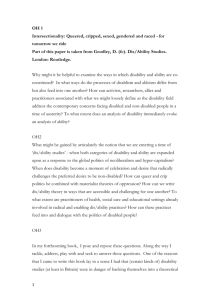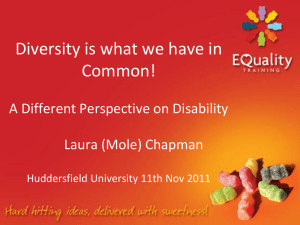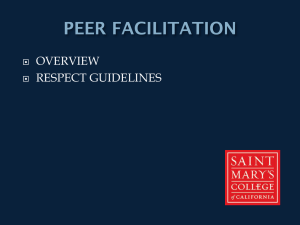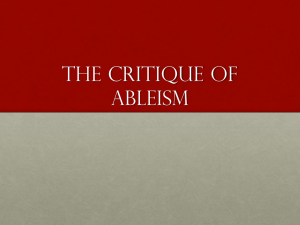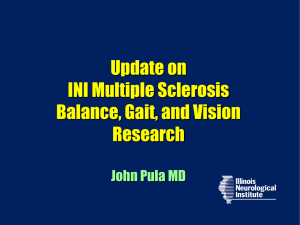Beyond Ocularnormativism
advertisement
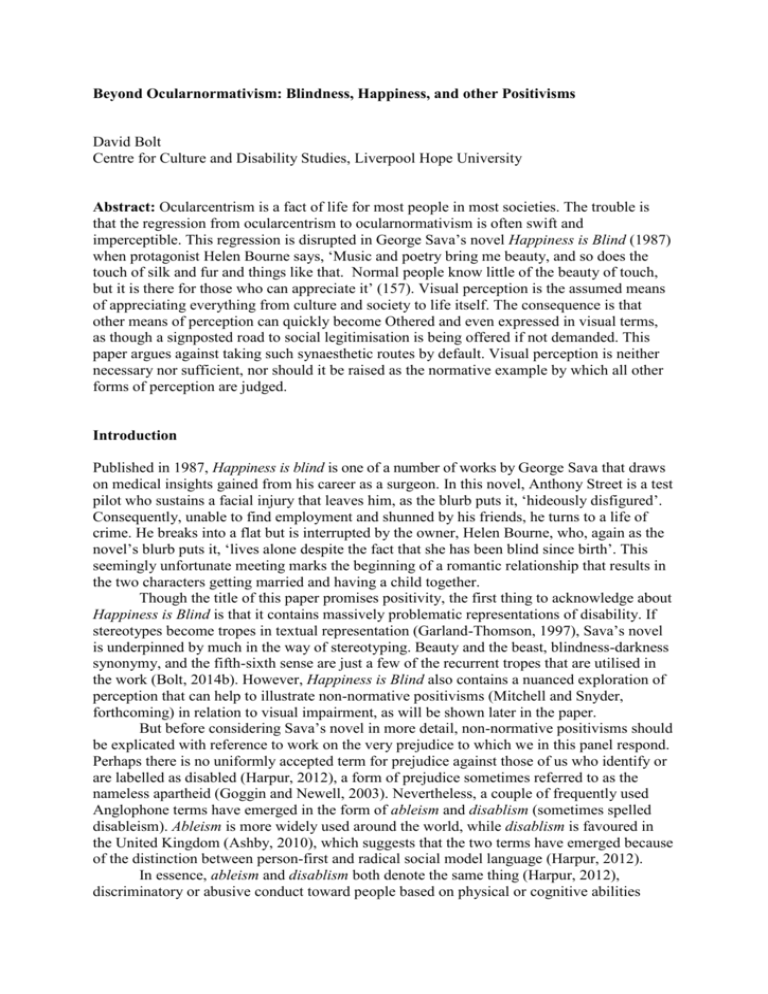
Beyond Ocularnormativism: Blindness, Happiness, and other Positivisms David Bolt Centre for Culture and Disability Studies, Liverpool Hope University Abstract: Ocularcentrism is a fact of life for most people in most societies. The trouble is that the regression from ocularcentrism to ocularnormativism is often swift and imperceptible. This regression is disrupted in George Sava’s novel Happiness is Blind (1987) when protagonist Helen Bourne says, ‘Music and poetry bring me beauty, and so does the touch of silk and fur and things like that. Normal people know little of the beauty of touch, but it is there for those who can appreciate it’ (157). Visual perception is the assumed means of appreciating everything from culture and society to life itself. The consequence is that other means of perception can quickly become Othered and even expressed in visual terms, as though a signposted road to social legitimisation is being offered if not demanded. This paper argues against taking such synaesthetic routes by default. Visual perception is neither necessary nor sufficient, nor should it be raised as the normative example by which all other forms of perception are judged. Introduction Published in 1987, Happiness is blind is one of a number of works by George Sava that draws on medical insights gained from his career as a surgeon. In this novel, Anthony Street is a test pilot who sustains a facial injury that leaves him, as the blurb puts it, ‘hideously disfigured’. Consequently, unable to find employment and shunned by his friends, he turns to a life of crime. He breaks into a flat but is interrupted by the owner, Helen Bourne, who, again as the novel’s blurb puts it, ‘lives alone despite the fact that she has been blind since birth’. This seemingly unfortunate meeting marks the beginning of a romantic relationship that results in the two characters getting married and having a child together. Though the title of this paper promises positivity, the first thing to acknowledge about Happiness is Blind is that it contains massively problematic representations of disability. If stereotypes become tropes in textual representation (Garland-Thomson, 1997), Sava’s novel is underpinned by much in the way of stereotyping. Beauty and the beast, blindness-darkness synonymy, and the fifth-sixth sense are just a few of the recurrent tropes that are utilised in the work (Bolt, 2014b). However, Happiness is Blind also contains a nuanced exploration of perception that can help to illustrate non-normative positivisms (Mitchell and Snyder, forthcoming) in relation to visual impairment, as will be shown later in the paper. But before considering Sava’s novel in more detail, non-normative positivisms should be explicated with reference to work on the very prejudice to which we in this panel respond. Perhaps there is no uniformly accepted term for prejudice against those of us who identify or are labelled as disabled (Harpur, 2012), a form of prejudice sometimes referred to as the nameless apartheid (Goggin and Newell, 2003). Nevertheless, a couple of frequently used Anglophone terms have emerged in the form of ableism and disablism (sometimes spelled disableism). Ableism is more widely used around the world, while disablism is favoured in the United Kingdom (Ashby, 2010), which suggests that the two terms have emerged because of the distinction between person-first and radical social model language (Harpur, 2012). In essence, ableism and disablism both denote the same thing (Harpur, 2012), discriminatory or abusive conduct toward people based on physical or cognitive abilities (Harpur, 2009). Some work, however, has sought to appreciate the respective merits of the terms (Campbell, 2008, 2009; Harpur, 2012; Bolt, 2014a). From such a perspective, ableism and disablism render radically different understandings of disability: the former is associated with the idea of ableness, the perfect or perfectible body, and the latter relates to the production of disability, in accordance with a social constructionist understanding (Campbell, 2008). Put differently, ableism renders nondisabled people supreme and disablism is a combination of attitudes and actions against those of us who identify or are labelled as disabled. Ableism: Normative Positivisms At this point in the paper it is worth focusing our attention on ableism, which has been defined as a political term that calls attention to assumptions about normalcy (Davis, 1995). It can be traced back to handicapism, a term coined nearly four decades ago to denote not only assumptions but also practices that promoted the unequal treatment of people because of apparent or assumed physical, mental, and/or behavioural differences (Bogdan and Biklen, 1977; Ashby, 2010). The concept of ableism, however, has been societally entrenched, deeply and subliminally embedded in culture, and rampant throughout history; it has been widely used by various social groups to justify their elevated rights and status in relation to other groups (Campbell, 2008; Wolbring, 2008). That is to say, whatever and however we term it, ableism is an age-old concept. There are many variants of ableism. Cognitive ableism, for instance, is a bias in favour of the interests of people who actually or potentially have certain cognitive abilities (Carlson, 2001); lexism is an array of normative practices, assumptions, and attitudes about literacy (Collinson, 2014); sanism is the privileging of people who do not have so-called mental health problems (Prendergast, 2014); and ocularcentrism is the dominance of visual perception on which this paper comes to focus (Jay, 1994). The list goes on and on, for there has been a proliferation of normative positivisms in modernity. A thing to remember is that when people endeavour to occupy the subject position of ableism, they buy into a myriad of normative assumptions but often do so without premeditation or intent: they do so by acquiescence. After all, ableism is a deeply rooted, farreaching network of beliefs, processes, and practices that produces a corporeal standard, a particular type of mind and body, which is projected as the perfect human (Campbell, 2001). This network of notions about health, productivity, beauty, and the value of human life itself, represented and perpetuated by public and private media, renders abilities such as productivity and competitiveness far more important than, say, empathy, compassion, and kindness (Rauscher and McClintock, 1997; Wolbring, 2008). Indeed, so pervasive is this network that people are likely to pick up a highly detailed working knowledge of ableism by osmosis alone. Irrespective of intent, the widespread endorsement of ableism has dire consequences for society. Many bodies and minds are constructed and positioned as Other, meaning that many people fall outside the dominant norms of bodily appearance and/or performance and thus face social and material exclusion (Ashby, 2010; Hodge and Runswick-Cole, 2013). From this perspective, impairments are necessarily negative: they must be improved, cured, or else eliminated altogether; they certainly cannot contribute to an affirmative subjectivity (Campbell, 2008). In effect, ableism becomes a combination of discrimination, power, and prejudice that is related to the cultural privileging of nondisabled people; it oppresses those of us who have so-called mental health problems, learning difficulties, physical impairments, sensory impairments, and so on (Rauscher and McClintock, 1997; Eisenhauer, 2007). In other words, the normative positivisms of ableism result in the exclusion, victimisation, and stigmatisation of those of us who identify or are labelled as disabled. Disablism: Non-normative Negativisms Despite its dramatic effects, Ableism has been referred to as a nebulous concept that evades both identification and definition (Hodge and Runswick-Cole, 2013). What is more, the term has been deemed limited in content and scope on the basis that it should not allude exclusively to disability, but should be used as an umbrella term (Wolbring, 2008), a call for terminological specificity that is answered to some extent by that second term, disablism. After all, although ableism itself is often obscured, the value it places on certain abilities leads to disablism (Wolbring, 2008; Hodge and Runswick-Cole, 2013). For the purpose of this paper, then, it might be said that the normative positivisms of ableism result in the nonnormative negativisms of disablism. The term disablism is derived from the radical social model of disability, whereby the everyday practices of society perpetuate oppressive structures on those of us who have impairments (Madriaga, 2007). Discriminatory, oppressive, and/or abusive behaviour arises from the belief that we are somehow inferior to non-disabled people (Miller, Parker, and Gillinson, 2004). As so-called less able people we are discriminated against and different abilities become disabilities (Thomas, 2004; Wolbring, 2008). Disablism, therefore, involves not only the social imposition of restrictions of activity but also the socially engendered undermining of psycho-emotional well being (Thomas, 2007). It is arguably a more profound, targeted, and specific development of ableism. This specificity notwithstanding, disablism is not necessarily explicit. Adapted from aversive racism theory, the term aversive disablism has been coined to denote subtle forms of prejudice (Deal, 2007). Like aversive racism, aversive disablism is often unintentional, so aversive disablists may recognize the problems of disablism without recognising their own prejudice (Deal, 2007). Given such subtleties, the suggestion in this paper is that ableism and disablism might be critically conceptualised on a continuum that moves from normative positivisms to non-normative negativisms. This ideological continuum can be illustrated with reference to cultural constructs of visual perception. Ocularcentrism, as already noted, is the dominance of visual perception that is a fact of life for most people in most societies and as such constitutes a cluster of normative positivisms. A consequence of this variant of ableism is that those of us who perceive by other than visual means are necessarily Othered. The normative positivisms, then, become non-normative negativisms as non-visual means of perception are judged in visual terms and thus found wanting. If we return to Sava’s Happiness is Blind, we can find this scenario represented when Helen becomes a mother: I want to see. I want to look on the sunshine. I want to see my child. All these years I've been happy and content in my darkness and now, when I've got something to be really happy about, I feel miserable for the first time. (Sava, 1987: 176) Here, normative positivisms dictate that motherhood is a fundamentally visual experience and non-normative negativisms that vision is a necessary condition of its enjoyment, if not success. Elsewhere designated ocular-normativism (Bolt, 2014b), this extract illustrates a disablist consequence of ocularcentrism. Toward Non-normative Positivisms The continuum of normative positivisms and non-normative negativisms can be disrupted by the recognition of non-normative positivisms. More specifically, the often swift and imperceptible regression from ocularcentrism to ocularnormativism can be blocked. Accordingly, the reader of Happiness is Blind is informed that Helen is unique because rather than in spite of her blindness, that she has ‘found the secret of turning disability into a source of strength’ (Sava, 1987: 163). This strength is illustrated when Helen not only persuades Tony to discuss but also to recognise virtues in his so-called ugliness: "You are easier to talk to than most people," she remarked, as they sipped their coffee. "Easier for me to talk to, perhaps, I should say. You see, so many people talk with their faces as well as their voices that I lose half their meaning. You have got to put all your meaning into your voice.” (Sava, 1987: 156) Here the idea is that, because of his facial injury, Tony’s mode of communication becomes focused on the verbal, an audible form that is particularly pertinent to Helen, given that she does not perceive the visual cues of body language. Non-normative positivisms are thus generated by the very meeting of these two disabled characters. Of course this representation of non-normative positivisms may raise concerns about compensatory powers, a notion widely problematised in relation to visual impairment (Bolt, 2014b). However, a close reading of Happiness is Blind can reveal a number of departures from ocularnormativism. For instance, music and poetry are said to bring Helen beauty, as does the touch of silk, fur, and so on. She goes on to explain that ‘normal people’ know little of such beauty but it is present for those who wish to appreciate it (Sava, 1987: 157). This comment on aesthetics, that the ‘resources of life are infinite to those who know how to draw on them’, surely diminishes all connotations of compensatory powers. Conclusion So although Happiness is Blind contains many problematic representations, as acknowledged from the start of this paper, it redeems itself on many counts. Helen goes through the ocularnormative phase of longing to see, but the eponymous state of happiness is ultimately found when the eye surgery is unsuccessful. She brings the novel to its conclusion by critiquing the sighted majority for looking on blindness as an affliction: ‘You do not know what it is to be blind, and you naturally think that without eyes our lives must be incomplete and denied most of the things you cherish. It is not true’ (Sava, 1987: 192). The salient point on which this paper must end is that these moments of happiness are not rendered legitimate by ocularnormative representation. Helen owns the means of perception that are available to her; she does not find her own way of seeing. For this reason it can be argued that the novel departs from ableism and disablism, that it ventures beyond ocularnormativism and sketches out the potential of non-normative positivisms. References Ashby, C. 2010. The trouble with normal: the struggle for meaningful access for middle school students with developmental disability labels. Disability & Society 25, no. 3: 345-358. Bogdan, R. and S. Biklen. 1998. Qualitative research for education: An introduction to theory and method. Boston, MA: Allyn & Bacon. Bolt, D. 2014a. Changing social attitudes toward disability: Perspectives from historical, cultural, and educational studies. London: Routledge. Bolt, D. 2014b. The metanarrative of blindness: A re-reading of twentieth-century Anglophone writing. Ann Arbor, MI: University of Michigan Press. Campbell, F. K. 2009. Frontiers of ableism. Australia: Palgrave Macmillan. Campbell, F. K. 2008. Exploring internalized ableism using critical race theory. Disability & Society 23, no. 2: 151 –162. Campbell, F. K. 2001. Inciting legal fictions: Disability’s date with ontology and the ableist body of the law. Griffith Law Review 10: 42–62. Carlson, L. 2001. Cognitive ableism and disability studies: Feminist reflections on the history of mental retardation. Hypatia 16, no. 4: 124-146. Collinson, C. 2014. 'Lexism' and the temporal problem of defining 'dyslexia'. In Changing social attitudes toward disability: Perspectives from historical, cultural, and educational studies, ed. D. Bolt. London: Routledge. Davis, L. J. 1995. Enforcing normalcy: Disability, deafness and the body. London: Verso Books. Deal, M. 2007. Aversive disablism: subtle prejudice toward disabled people, Disability & Society 22, no. 1: 93-107. Garland-Thomson, R. 1997. Extraordinary bodies: Figuring physical disability in American culture and literature. New York, NY: Columbia University Press. Goggin, G. and C. Newell. 2003. Disability in Australia: Exposing a social apartheid. Sydney: University of New South Wales Press. Eisenhauer, J. 2007. Just looking and staring back: Challenging ableism through disability performance art. Studies in Art Education A Journal of Issues and Research 49, no. 1: 7-22. Harpur, P. 2012. From disability to ability: changing the phrasing of the debate, Disability & Society 27, no. 3: 325-337. Harpur, P. 2009. Sexism and racism, why not ableism?: Calling for a cultural shift in the approach to disability discrimination. Alternative Law Journal 35, no. 3: 163–7. Hodge, N. and K. Runswick-Cole. 2013. ‘They never pass me the ball’: exposing ableism through the leisure experiences of disabled children, young people and their families, Children's Geographies 11, no. 3: 311-325. Jay, M. 1994. Downcast eyes: The denigration of vision in twentieth-century French thought. Berkeley, CA and London: University of California Press. Madriaga, M. 2007. Enduring disablism: students with dyslexia and their pathways into UK higher education and beyond, Disability & Society 22, no. 4: 399-412. Miller, P., Parker, S. and Gillinson, S. 2004. Disablism: how to tackle the last prejudice. London: Demos. Mitchell, D. T. and Snyder, S. L. Forthcoming. The biopolitics of disability: Neoliberalism, ablenationalism, and peripheral embodiment. Prendergast, C. 2014. Mental disability and rhetoricity retold: The memoir on drugs. In Changing social attitudes toward disability: Perspectives from historical, cultural, and educational studies, ed. D. Bolt. London: Routledge. Sava, G. 1987. Happiness is blind. London: Robert Hale Ltd. Thomas, C. 2007. Sociologies of disability, ‘impairment’, and chronic illness: Ideas in disability studies and medical sociology. London: Palgrave. Thomas, C. 2004. Developing the social relational in the social model of disability: A theoretical agenda. In Implementing the social model of disability: Theory and research, ed. C. Barnes and G. Mercer, 32–47. Leeds: The Disability Press. Rauscher, L. and M. McClintock. 1997. Ableism curriculum design. In Teaching for diversity and social justice: A sourcebook, ed. M. Adams, L. Bell, and P. Griffin, 198–230. New York, NY: Routledge. Wolbring, G. 2008. The politics of ableism. Development, 51: 252-258.
